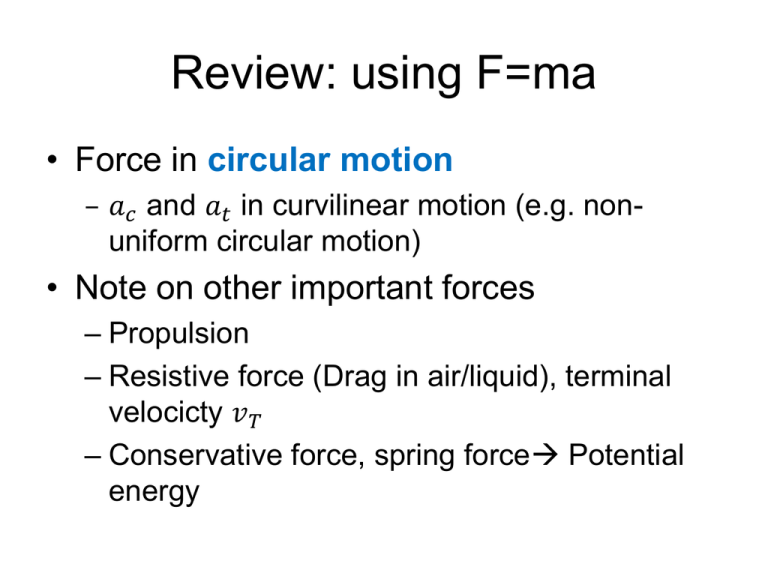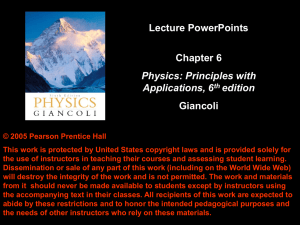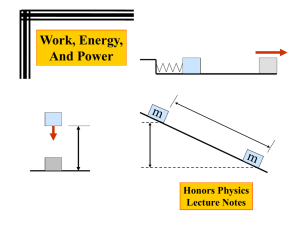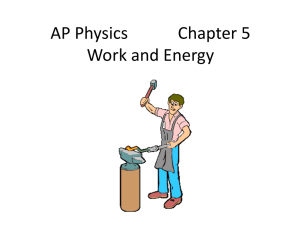4.1 The Concepts of Force and Mass
advertisement

Review: using F=ma • Force in circular motion – 𝑎𝑐 and 𝑎𝑡 in curvilinear motion (e.g. nonuniform circular motion) • Note on other important forces – Propulsion – Resistive force (Drag in air/liquid), terminal velocicty 𝑣𝑇 – Conservative force, spring force Potential energy Relevant concepts: “inertia” and force a) Inertial reference frame b) accelerated frame of the car - fictitious force Rolling friction Conical Pendulum (e.g. ชิงช้าหมุน) •The object is in equilibrium in the vertical direction. •It undergoes uniform circular motion in the horizontal direction. ∑𝐹𝑦 = 0 → 𝑇 cos 𝜃 = 𝑚𝑔 ∑𝐹𝑥 = 𝑇 sin 𝜃 = 𝑚 𝑎𝑐 •v is independent of m Car traveling in a banked curve •Design the curve with no friction –in equilibrium in the vertical direction. –in uniform circular motion in the horizontal direction a component of the normal force supplies the centripetal force. •The angle of bank is ta n •Note: v 2 rg –The banking angle is independent of the mass of the vehicle. –If the car rounds the curve at less than the design speed, friction is necessary to keep it from sliding down the bank. –If the car rounds the curve at more than the design speed, friction is necessary to keep it from sliding up the bank. Car traveling in a horizontal (Flat) Curve •uniform circular motion in the horizontal direction. •in equilibrium in the vertical direction. •The force of static friction supplies the centripetal force. •The maximum speed at which the car can negotiate the curve is: v s gr – Note: this does not depend on the mass of the car. Section 6.1 Ferris Wheel •Uniform circular motion with constant speed v (controlled by the motor) 𝑭𝒏𝒆𝒕 𝑭𝒏𝒆𝒕 𝑚𝑣 2 = (−𝒓) 𝑅 𝑭𝒏𝒆𝒕 •Under gravity, the child feels apparent weight differently at top and bottom Section 6.1 Ferris Wheel (2) •At the bottom of the loop, the upward force (the normal) experienced by the object is greater than its weight. F n bot m g mv •At the top of the circle, the force exerted on the object is less than its weight. 2 F r v n bot m g 1 rg 2 n to p Section 6.1 n to p m g v2 mg 1 rg mv r 2 Non-uniform Circular Motion If the speed also changes in magnitude there is non-zero tangential acceleration Section 6.2 Vertical Circle with Non-Uniform Speed •Launch by shooting (say, from the bottom at initial velocity 𝒗𝒃𝒐𝒕 ). The string restricts motion to a circle of radius R (1 DOF) •What is T and acceleration? •Tension depends on position 𝜃(𝑡) d𝜃 and speed 𝑣 𝑡 = 𝑑𝑡 𝑅 ,both varying with time •The tension at the bottom is a maximum. •The tension at the top is a minimum. •Requires critical speed 𝑣𝑡𝑜𝑝 ≥ 𝑅𝑔 to complete the circle (𝑇𝑡𝑜𝑝 ≥ 0 at 𝜃 = 𝜋) Section 6.2 v2 T mg co s Rg Resistive force (or drag force in air/fluid) and terminal velocity 𝑣𝑇 (this topic is not in the test) Resistive force 𝑭𝑫 could be of either form(linear or quadratic to 𝑣), but always opposite direction to motion (−𝒗) 1. Linear (Stokes law in liquid) 𝑭𝑫 ∝ − 𝒗 𝐹𝐷 = −𝑏𝑣 vT mg b 2. Quadratic (air resistance) 𝑭𝑫 ∝ −𝑣 2 1 𝐹𝐷 = − 𝐶𝐷 𝜌𝐴 𝑣 2 2 𝐶𝐷 is the drag coefficient (empirical, no dimension, 1 typically 𝐶𝐷 ≈ ). 2 𝜌 is the density of air. 𝐴 is the cross-sectional area of the object 𝑣𝑇 ≈ 4𝑚𝑔 𝜌𝐴 Lecture 4 Work and Energy Outline • Work done by a constant force – Projection and scalar product of vectors • Force that results in positive work. – negative work? forces that do no work? • Work done by varying force with displacement • Work-energy theorem 6.1 Work Done by a Constant Force W Fs 1 N m 1 joule J 6.1 Work Done by a Constant Force Work, cont. •W = F Dr cos – A force does no work on the object if the force does not move through a displacement. – The work done by a force on a moving object is zero when the force applied is perpendicular to the displacement of its point of application. Section 7.2 6.1 Work Done by a Constant Force W F cos s cos 0 1 cos 90 0 cos 180 1 6.1 Work Done by a Constant Force Example 1 Pulling a Suitcase-on-Wheels Find the work done if the force is 45.0-N, the angle is 50.0 degrees, and the displacement is 75.0 m. W F cos s 45 . 0 N cos 50 . 0 2170 J 75 .0 m 6.1 Work Done by a Constant Force W F cos 0 s Fs W F cos 180 s Fs 6.1 Work Done by a Constant Force Example 3 Accelerating a Crate The truck is accelerating at a rate of +1.50 m/s2. The mass of the crate is 120-kg and it does not slip. The magnitude of the displacement is 65 m. What is the total work done on the crate by all of the forces acting on it? f s m a 120 kg 1.5 m s 2 180 N W 180 N cos 0 65 m 1 . 2 10 J 4 6.1 Work Done by a Constant Force The angle between the displacement and the friction force is 0 degrees. f s ma 120 kg 1 . 5 m s 2 180 N W 180 N cos 0 65 m 1 . 2 10 J 4 Scalar Product of Two Vectors A B A B cos W F D r co s F D r Section 7.3 Scalar Product, cont •The scalar product is commutative. A B B A •The scalar product obeys the distributive law of multiplication. A B C A B A C Section 7.3 Dot Products of Unit Vectors ˆi ˆi ˆj ˆj kˆ kˆ 1 ˆi ˆj ˆi kˆ ˆj kˆ 0 Using component form with vectors: A A x ˆi A y ˆj A z kˆ B B x ˆi B y ˆj B z kˆ A B Ax B x Ay B y Az B z In the special case where A B; A A A x Ay Az A 2 Section 7.3 2 2 2 6.2 The Work-Energy Theorem and Kinetic Energy Consider a constant net external force acting on an object. The object is displaced a distance s, in the same direction as the net force. F s The work is simply W F s ma s 6.2 The Work-Energy Theorem and Kinetic Energy W m as m 1 2 v v 2 f 2 o 1 2 mv 2 f 1 2 v f v o 2 ax 2 2 ax 1 2 v 2 f vo 2 DEFINITION OF KINETIC ENERGY The kinetic energy KE of and object with mass m and speed v is given by KE 1 2 mv 2 mv 2 o 6.2 The Work-Energy Theorem and Kinetic Energy THE WORK-ENERGY THEOREM When a net external force does work on and object, the kinetic energy of the object changes according to W KE f KE o 1 2 mv 2 f 1 2 mv 2 o 6.2 The Work-Energy Theorem and Kinetic Energy Example 4 Deep Space 1 The mass of the space probe is 474-kg and its initial velocity is 275 m/s. If the 56.0-mN force acts on the probe through a displacement of 2.42×109m, what is its final speed? 6.2 The Work-Energy Theorem and Kinetic Energy W W F cos s 1 2 mv 2 f 1 2 mv 2 o 6.2 The Work-Energy Theorem and Kinetic Energy F cos s 5.60 10 -2 N cos 0 2 . 42 10 m 9 1 2 1 2 mv f 2 474 1 2 kg v f 2 2 mv o 1 2 474 kg 275 m s v f 805 m s 2 6.2 The Work-Energy Theorem and Kinetic Energy In this case the net force is F mg sin 25 f k 6.2 The Work-Energy Theorem and Kinetic Energy Conceptual Example 6 Work and Kinetic Energy A satellite is moving about the earth in a circular orbit and an elliptical orbit. For these two orbits, determine whether the kinetic energy of the satellite changes during the motion. W>0 W<0 W>0 W<0 6.3 Gravitational Potential Energy W F cos s W gravity mg h o h f 6.3 Gravitational Potential Energy W gravity mg h o h f Work due to gravity is independent of path! We call this phenomenon “conservative force” We can define “potential energy” based on this force 6.3 Gravitational Potential Energy Example 7 A Gymnast on a Trampoline The gymnast leaves the trampoline at an initial height of 1.20 m and reaches a maximum height of 4.80 m before falling back down. What was the initial speed of the gymnast? 6.3 Gravitational Potential Energy W gravity mgh o mgh f DEFINITION OF GRAVITATIONAL POTENTIAL ENERGY The gravitational potential energy PE is the energy that an object of mass m has by virtue of its position relative to the surface of the earth. That position is measured by the height h of the object relative to an arbitrary zero level: PE mgh 1 N m 1 joule J 6.4 Conservative Versus Nonconservative Forces DEFINITION OF A CONSERVATIVE FORCE Version 1 A force is conservative when the work it does on a moving object is independent of the path between the object’s initial and final positions. Version 2 A force is conservative when it does no work on an object moving around a closed path, starting and finishing at the same point. 6.4 Conservative Versus Nonconservative Forces 6.4 Conservative Versus Nonconservative Forces Version 1 A force is conservative when the work it does on a moving object is independent of the path between the object’s initial and final positions. W gravity mg h o h f 6.4 Conservative Versus Nonconservative Forces Version 2 A force is conservative when it does no work on an object moving around a closed path, starting and finishing at the same point. W gravity mg h o h f ho h f 6.4 Conservative Versus Nonconservative Forces An example of a nonconservative force is the kinetic frictional force. W F cos s f k cos 180 s f k s The work done by the kinetic frictional force is always negative. Thus, it is impossible for the work it does on an object that moves around a closed path to be zero. The concept of potential energy is not defined for a nonconservative force. 6.4 Conservative Versus Nonconservative Forces In normal situations both conservative and nonconservative forces act simultaneously on an object, so the work done by the net external force can be written as W W c W nc W KE f KE o D KE W c W gravity mgh o mgh f PE o PE f D PE Spring force and Spring (Elastic) Potential Energy 6.4 Conservative Versus Nonconservative Forces Work done by conservative force W W c W nc Work done by non-conservative force D KE D PE W nc THE WORK-ENERGY THEOREM W nc D KE D PE 6.5 The Conservation of Mechanical Energy W nc D KE D PE KE f KE o PE f PE o W nc E f E o If the net work on an object by nonconservative forces is zero, then its energy does not change: Ef Eo 6.5 The Conservation of Mechanical Energy THE PRINCIPLE OF CONSERVATION OF MECHANICAL ENERGY The total mechanical energy (E = KE + PE) of an object remains constant as the object moves, provided that the net work done by external nononservative forces is zero. 6.5 The Conservation of Mechanical Energy 6.5 The Conservation of Mechanical Energy Example 8 A Daredevil Motorcyclist A motorcyclist is trying to leap across the canyon by driving horizontally off a cliff 38.0 m/s. Ignoring air resistance, find the speed with which the cycle strikes the ground on the other side. 6.5 The Conservation of Mechanical Energy Ef Eo mgh f 1 2 mv gh f 1 2 2 f mgh o v f gh o 2 1 2 1 2 mv 2 vo 2 o 6.5 The Conservation of Mechanical Energy gh f vf vf 2 9 .8 m s 2 1 2 v f gh o 2 2 g h o hf 1 2 2 vo v 2 o 35 .0 m 38 .0 m s 2 46 . 2 m s 6.5 The Conservation of Mechanical Energy Conceptual Example 9 The Favorite Swimming Hole The person starts from rest, with the rope held in the horizontal position, swings downward, and then lets go of the rope. Three forces act on him: his weight, the tension in the rope, and the force of air resistance. Can the principle of conservation of energy be used to calculate his final speed? 6.7 Power DEFINITION OF AVERAGE POWER Average power is the rate at which work is done, and it is obtained by dividing the work by the time required to perform the work. P Work Time joule W t s watt (W) 6.7 Power P Change in energy Time 1 horsepower 550 foot pounds P Fv second 745.7 watts 6.7 Power 6.8 Other Forms of Energy and the Conservation of Energy THE PRINCIPLE OF CONSERVATION OF ENERGY Energy can neither be created not destroyed, but can only be converted from one form to another. • Where does work due to nonconservative force (Wnc) go to, other than kinetic energy? • Thermal energy (heat) as internal energy of materials • This means energy of the universe (isolated system) is always conserved. – When we say “not energy conserving” we mean just in the subsystem. Lecture 5 Impulse and Momentum 7.1 The Impulse-Momentum Theorem There are many situations when the force on an object is not constant. 7.1 The Impulse-Momentum Theorem DEFINITION OF IMPULSE The impulse of a force is the product of the average force and the time interval during which the force acts: J F Dt Impulse is a vector quantity and has the same direction as the average force. newton seconds (N s) 7.1 The Impulse-Momentum Theorem J F Dt 7.1 The Impulse-Momentum Theorem DEFINITION OF LINEAR MOMENTUM The linear momentum of an object is the product of the object’s mass times its velocity: p mv Linear momentum is a vector quantity and has the same direction as the velocity. kilogram meter/seco nd (kg m/s) 7.1 The Impulse-Momentum Theorem a vf vo F ma m v m v f o F Dt F Dt mv f mv o Dt 7.1 The Impulse-Momentum Theorem IMPULSE-MOMENTUM THEOREM When a net force acts on an object, the impulse of this force is equal to the change in the momentum of the object impulse F Dt mv f mv o final momentum initial momentum 7.1 The Impulse-Momentum Theorem Example 2 A Rain Storm Rain comes down with a velocity of -15 m/s and hits the roof of a car. The mass of rain per second that strikes the roof of the car is 0.060 kg/s. Assuming that rain comes to rest upon striking the car, find the average force exerted by the rain on the roof. F Dt mv f mv o 7.1 The Impulse-Momentum Theorem Neglecting the weight of the raindrops, the net force on a raindrop is simply the force on the raindrop due to the roof. F Dt mv f mv o m F vo Dt F 0 . 060 kg s 15 m s 0 . 90 N 7.1 The Impulse-Momentum Theorem Conceptual Example 3 Hailstones Versus Raindrops Instead of rain, suppose hail is falling. Unlike rain, hail usually bounces off the roof of the car. If hail fell instead of rain, would the force be smaller than, equal to, or greater than that calculated in Example 2? 7.2 The Principle of Conservation of Linear Momentum sum of average external forces D t P f P o If the sum of the external forces is zero, then 0 Pf Po Pf Po PRINCIPLE OF CONSERVATION OF LINEAR MOMENTUM The total linear momentum of an isolated system is constant (conserved). An isolated system is one for which the sum of the average external forces acting on the system is zero. 7.2 The Principle of Conservation of Linear Momentum Conceptual Example 4 Is the Total Momentum Conserved? Imagine two balls colliding on a billiard table that is friction-free. Use the momentum conservation principle in answering the following questions. (a) Is the total momentum of the two-ball system the same before and after the collision? (b) Answer part (a) for a system that contains only one of the two colliding balls. 7.2 The Principle of Conservation of Linear Momentum Example 6 Ice Skaters Starting from rest, two skaters push off against each other on ice where friction is negligible. One is a 54-kg woman and one is a 88-kg man. The woman moves away with a speed of +2.5 m/s. Find the recoil velocity of the man. 7.2 The Principle of Conservation of Linear Momentum Pf Po m1v f 1 m 2 v f 2 0 vf2 vf2 54 m1v f 1 m2 kg 2 . 5 m s 88 kg 1 .5 m s 7.2 The Principle of Conservation of Linear Momentum Applying the Principle of Conservation of Linear Momentum 1. Decide which objects are included in the system. 2. Relative to the system, identify the internal and external forces. 3. Verify that the system is isolated. 4. Set the final momentum of the system equal to its initial momentum. Remember that momentum is a vector. การชนกัน (collision) - ในการชนส่ วนใหญ่ เราไม่ทราบแรงชน จึงไม่สามารถวิเคราะห์ การเคลื่อนที่โดยใช้กฎของนิวตันได้ - แต่หากทราบลักษณะการเคลื่อนที่ (ความเร็ ว) การวิเคราะห์การเคลื่อนที่ สาหรับการชนสามารถใช้หลักอนุรักษ์ โมเมนตัมได้ - กรณี ที่เป็ นการชนแบบยืดหยุ่น เป็ นการชนแบบไมสู ่ ญเสี ย พลังงานจลน์ สามารถใช้หลักอนุรักษ์ พลังงานจลน์ ซ่ ึง หมายถึง พลังงานจลน์รวมของระบบก่อนและหลังชนมีค่าเท่ากัน - กรณี ที่เป็ นการชนแบบไม่ ยดื หยุ่น พลังงานจลนของระบบ ์ จะลดลง เนื่องจากพลังงานจลน์เปลี่ยนรู ปเป็ น เสี ยง ความร้อน เป็ นต้น 80 เชน หลังชนวัตถุตด ิ กัน 7.3 Collisions in One Dimension The total linear momentum is conserved when two objects collide, provided they constitute an isolated system. Elastic collision -- One in which the total kinetic energy of the system after the collision is equal to the total kinetic energy before the collision. Inelastic collision -- One in which the total kinetic energy of the system after the collision is not equal to the total kinetic energy before the collision; if the objects stick together after colliding, the collision is said to be completely inelastic. Example of elastic collision in 1D 7.3 Collisions in One Dimension Example 8 A Ballistic Pendulum The mass of the block of wood is 2.50-kg and the mass of the bullet is 0.0100-kg. The block swings to a maximum height of 0.650 m above the initial position. Find the initial speed of the bullet. 7.3 Collisions in One Dimension Apply conservation of momentum to the collision: m 1v f 1 m 2 v f 2 m 1v o1 m 2 v o 2 m 1 m 2 v f m1v o1 Inelastic collision v o1 m 1 m 2 v f m1 7.3 Collisions in One Dimension Applying conservation of energy to the swinging motion: mgh m 1 m 2 gh f 1 2 mv 1 2 gh f vf 2 gh f 2 m 1 m 2 v 2f 1 2 2 vf 2 9 . 80 m s 2 0 .650 m 7.3 Collisions in One Dimension vf v o1 v o1 2 9 . 80 m s 2 0 . 650 m m 1 m 2 v f m1 0 . 0100 kg 2 . 50 kg 2 2 9 . 80 m s 0 . 650 m 896 m s 0.0100 kg 7.5 Center of Mass The center of mass is a point that represents the average location for the total mass of a system. x cm m 1 x1 m 2 x 2 m1 m 2 7.5 Center of Mass D x cm m 1 D x1 m 2 D x 2 m1 m 2 v cm m 1 v1 m 2 v 2 m1 m 2 7.5 Center of Mass v cm m 1 v1 m 2 v 2 m1 m 2 In an isolated system, the total linear momentum does not change, therefore the velocity of the center of mass does not change. 7.5 Center of Mass BEFORE v cm m 1 v1 m 2 v 2 m1 m 2 0 AFTER v cm 88 kg 1 . 5 m s 54 kg 2 . 5 m s 88 kg 54 kg 0 . 002 0








